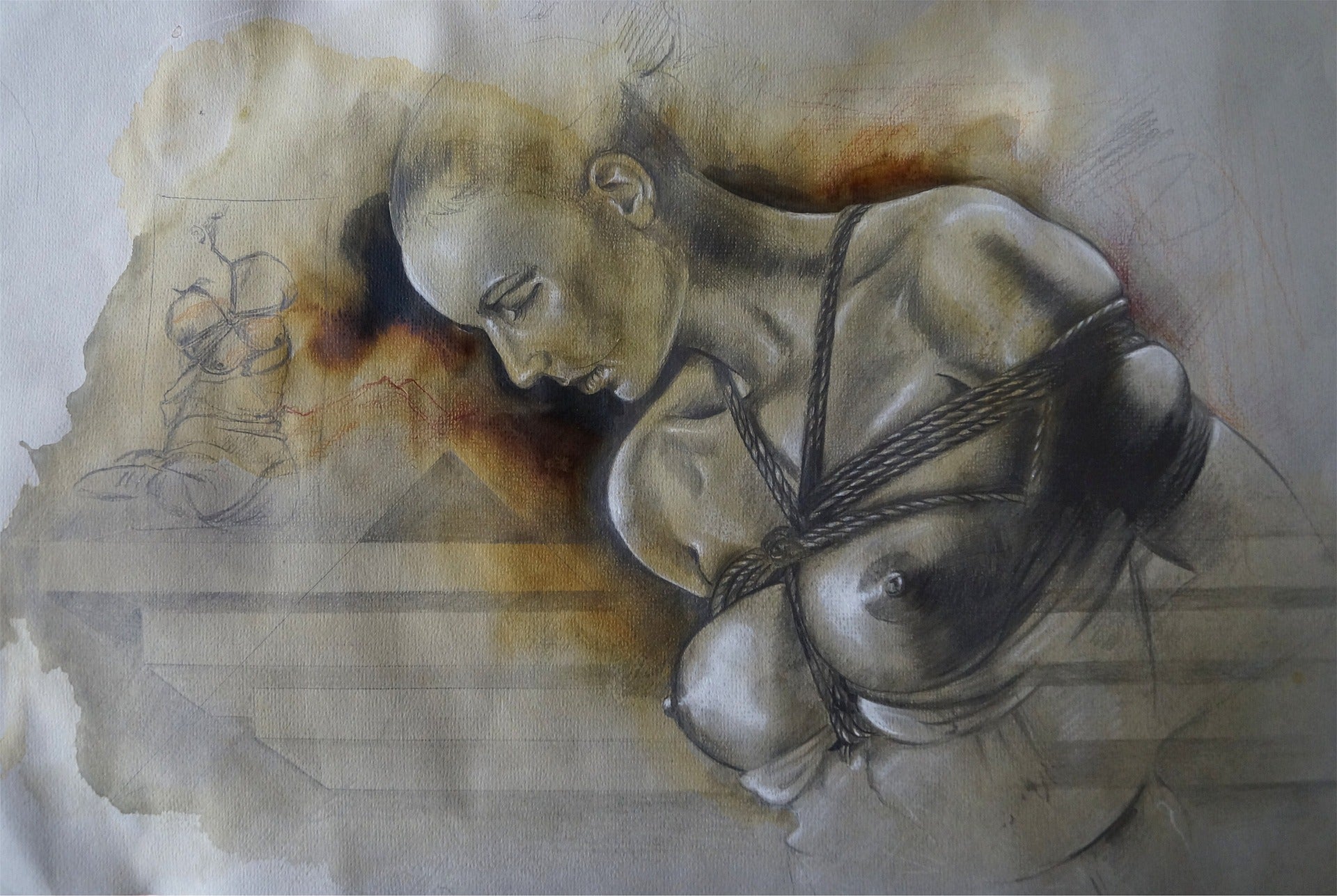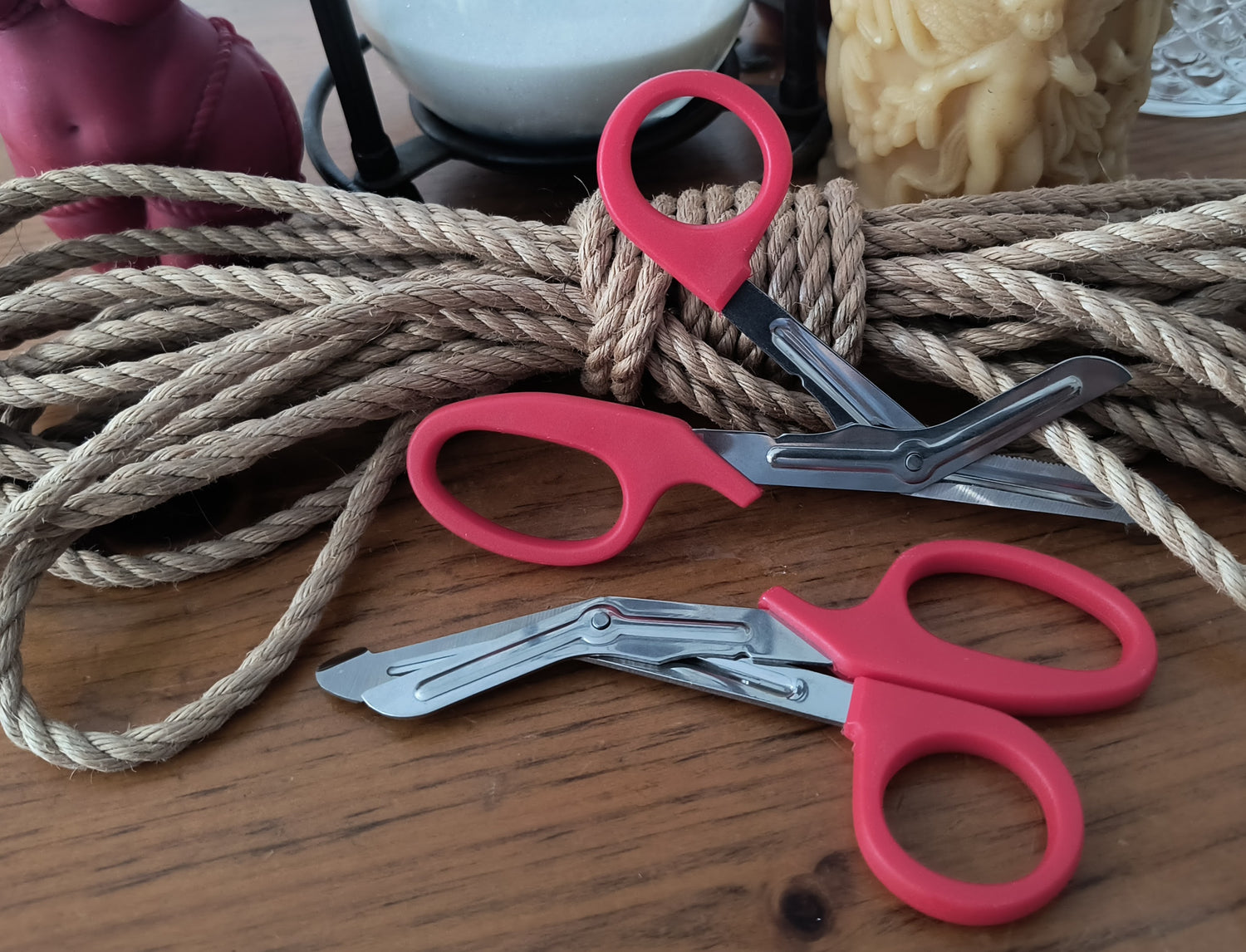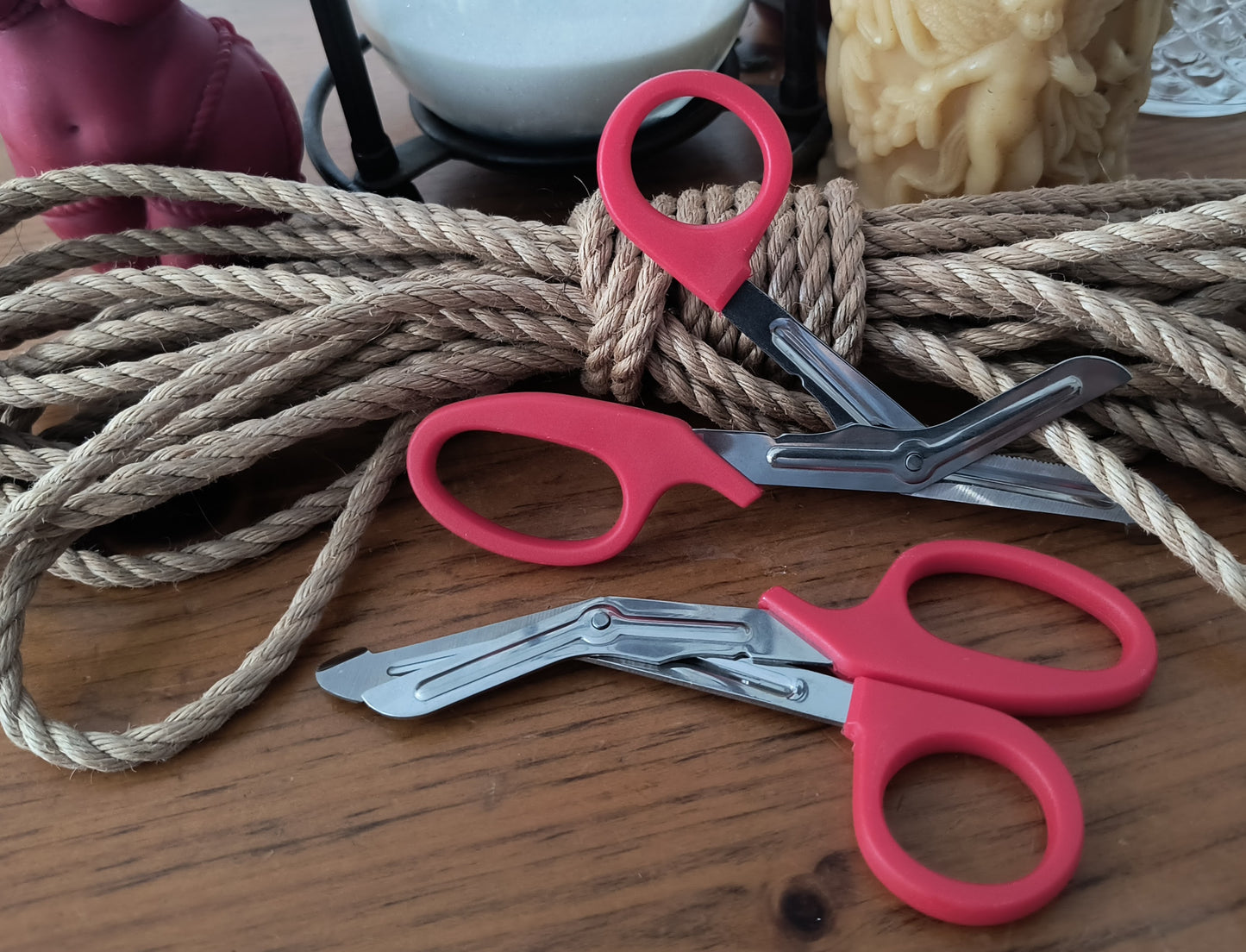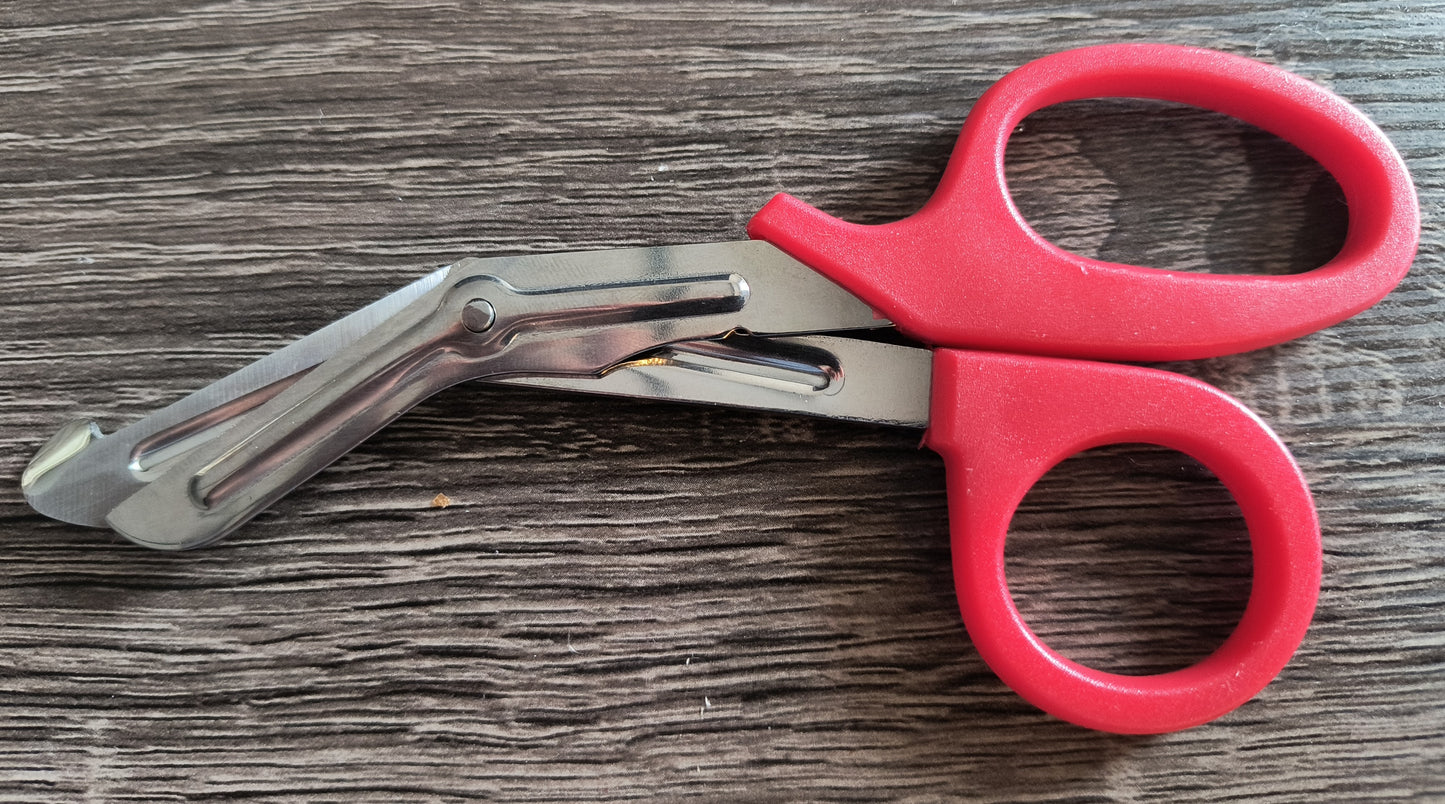
Rope Bondage Safety
Essential Knowledge for Responsible Play
Rope bondage, whether practiced as art, intimacy, or ritual,
demands a serious commitment to safety.
Rope play requires that practitioners and participants recognize that all activities carry risk
and informed consent and mitigation strategies are essential.
We encourage the mindset of Risk-Aware Consensual Kink (RACK): understand these risks, and choose to engage with them consciously. This is the responsibility of every rigger and bottom involved in this practice.
From nerve damage to circulation loss, the potential for injury is real, but with knowledge, communication, and preparation, many of these risks can be minimized or avoided.

Safety Shears
Your Most Important Tool
Every rope scene should begin with one key item close at hand: a pair of safety shears. These are not optional.
In the event of an emergency, safety shears allow you to cut rope quickly and safely without harming the person tied. Choose EMT shears or similar tools designed to cut through rope safely and with minimal effort. Always keep them within reach throughout the entire scene.
It is important to remember: rope is replaceable; people are not. No matter how expensive or sentimental a piece of rope might be, it is never worth more than a person’s life or long-term health. If something goes wrong, cut the rope without hesitation.
Common Injuries and How They Happen
Collapsible content
Nerve Damage
The most common major injury in rope bondage is nerve compression, especially of the radial nerve in the upper arm or the peroneal nerve in the leg. Symptoms can include numbness, tingling, weakness, or loss of function. Damage can occur quickly and may not be immediately painful.
One specific symptom of radial nerve damage, commonly seen in rope bondage, is "wrist drop," where the affected individual is unable to lift their wrist or fingers, resulting in a limp hand.
When arms are bound, check the radial nerve with a grip test: place your hand in the bottom’s palm and have them squeeze firmly. Any weakness indicates nerve compression and requires immediate adjustment.
Recovery from nerve damage can take months, or even years. In severe cases, permanent loss of function or sensation may occur, and the damage could be irreversible.
Circulatory Issues
Tight bindings can restrict blood flow, leading to tingling, swelling, coldness, or discoloration in extremities. While this is usually reversible, prolonged circulation loss can cause serious harm.
Wiggling the limbs and extremities can help restore blood flow and ensure movement remains unrestricted.
Discomfort or pain can be eased by adjusting body position, shifting weight, or loosening the rope.
Strangulation
If the rope slips or shifts unexpectedly onto the neck, as can happen in some suspension positions, airways may be constricted or blood flow to the brain halted. This is an extremely dangerous situation.
Riggers must be especially cautious when using rope near the neck or high on the
shoulders and constantly check to ensure the rope is secure and not at risk of slipping. Regular verbal and non-verbal check-ins are essential to ensure the person being tied is not experiencing any difficulty breathing.
Falls and Suspension Risks
In suspension bondage, the stakes are higher. Falls from rope breakage or slippage, improper suspension technique, or a failed hard point can cause significant trauma.
Skin Abrasions and Bruising
Rope burns, abrasions, and bruises can result from improper technique, excessive tension, or unsuitable rope materials. However, even with correct technique, rope marks and bruises can and do occur—particularly during more intense ties or suspensions, where increased pressure, body weight, and prolonged duration leads to a physical imprint.
These marks are generally superficial and temporary. Many bottoms not only expect them but embrace them as cherished reminders of their experience. As always, these outcomes should be fully understood and consented to before play begins.
Preventing Injury
Collapsible content
Educate Yourself
Take classes, attend workshops, and read from reputable sources. Learn about anatomy, rope handling, and scene negotiation.
Communicate Clearly
Before tying, discuss risk tolerance, safe words/signals, physical limitations, and
previous injuries.
Check In Regularly
Throughout the scene, especially in suspension, check in frequently with your partner. Ask about sensation, temperature, and movement.
Verify if they still have sensation with a light touch or squeeze. Monitor the radial nerve when the arms are bound by doing a grip test (have them squeeze your hand).
Relieve any numbness or tingling by shifting their body position, or weight, and/or the loosening rope. Don't hesitate to end the scene if anyone has any concerns about continuing.
Avoid Risk Zones
Learn the common nerve paths and avoid applying direct pressure over them. Avoid compressing risk areas such as the upper inner arm, the inside of the knee, or the wrist.
E.g.: the most common serious injury is a radial nerve compression, a.k.a. "wrist drop". In most people the radial nerve runs through the valley between the deltoid and the triceps. This is an area to avoid.
When the arms are rotated and bound behind the back the radial nerve is exposed and any rope on the upper arms should put their pressure directly on the muscles and avoid the gap between them.
Keep Sessions Short and Mindful
Never leave someone tied up and unattended. Monitor time spent in bondage, especially in complex or tight positions.
Use Appropriate Rope
Natural fibers like jute or hemp are often preferred for their tooth and feedback, but
should be well maintained. Avoid stiff or abrasive rope for longer scenes.
What To Do If Injury Occurs
Collapsible content
Numbness or Tingling
Untie immediately. Do not wait to see if the sensation resolves. Encourage gentle
movement and massage. If symptoms persist longer than an hour, seek medical
advice.
Loss of Conscousness
Immediately stop all activity and ensure the airway is clear. If necessary, check for
breathing and pulse. Begin CPR if needed and call emergency services right away. Do not continue the scene or attempt to revive the person with anything other than medical attention.
Loss of Circulation
Look for pale, blue, or cold extremities. Loosen the rope immediately and elevate
the limb. Recovery is usually quick, but extended loss of circulation may warrant
medical attention.
Fall Injury
If someone falls or is dropped in suspension, treat the scene like any trauma situation. Do not move the head or neck if a spinal injury is possible or suspected. Check for consciousness, bleeding, or fractures, and call emergency services if necessary.
Suspension Safety
Elevated Risk, Elevated Responsibility
Suspension bondage carries significantly more risk and should only be attempted by
experienced practitioners
Collapsible content
Hard Points
Always use climbing-rated gear and hard points that have been professionally installed, load rated, and tested. A failed hard point can lead to catastrophic injury.
Spotting and Support
Always have a spotter when suspending. A spotter can help raise or lower the bottom and assist in emergencies. Never, ever self-suspend alone.
Check Ins
Because nerve damage can happen quickly and without pain, regular verbal and non-verbal check-ins are essential. If the bottom cannot speak, establish clear physical signals.
Never Leave a Suspended Bottom Unattended
If something goes wrong, time is of the essence. Your full attention should be on the person in the air at all times.
Seiðr & Wyrd Kink Co.
EMT Safety Shears
Share


-
Premium Jute Bondage Rope - Whipped Ends
Regular price From $15.99 CADRegular price -
Premium Jute Bondage Rope - Knotted Ends
Regular price From $12.99 CADRegular price -
Raw Jute Rope
Regular price $1.00 CADRegular price -
Rope Butter
Regular price $16.49 CADRegular price





